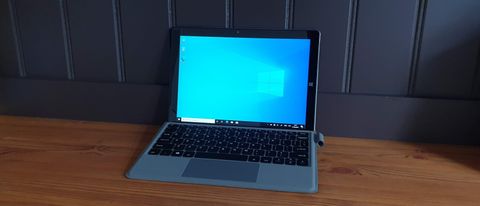TechRadar Verdict
The Alldocube iWork 20 Pro 2-in-1 Windows tablet is a decent candidate should you want to get a small Windows slate and while we’re not big fans of the form factor, we do see the appeal of having a tablet that can be used to do light work.
Pros
- +
True 10.5-inch form factor with 3:2 aspect ratio
- +
Decent overall showing
- +
Bundled keyboard
- +
Good battery life
Cons
- -
Weak storage performance
- -
Bluetooth 4.2
- -
More expensive than expected
Why you can trust TechRadar
Two minute review
Microsoft recently announced the third iteration of its surprisingly popular Surface Go 2-in-1 convertible laptop. The device has spawned a generation of wannabes with the Chuwi Hi10 Go being the most recently reviewed one.
The Alldocube iWork 20 Pro joins the list with what - on paper - looks like a compelling alternative to the Surface Go 3, albeit with a slightly lower specification and a much, much lower price tag as well. It performs generally well (for a Celeron-class product) across a wide range of benchmarks - except for its abysmal storage performance - plus it is reasonably portable and decently connected.
The form factor though remains a bit of a tricky one for those looking to use it to type. The keyboard cover and the tiny touchpad are simply not good enough for productivity fans. It’s not that they are intrinsically bad, it’s more that they can’t defy the laws of physics. The constraints associated with the layout and the need to keep everything lightweight and compact bring up a number of challenges.
Pricing and availability
The Alldocube iWork 20 Pro costs $319 at online Chinese retailer Banggood. It comes with a free keyboard cover but excludes taxes, delivery, admin fees and other charges that may be levied by local authorities or your courier (Want to buy tech from online Chinese retailers? Read this first). In comparison, the Surface Go 3 costs $634.98 with a faster processor, almost double the price.

Design
We are pleasantly surprised by the finish of the iWork 20 Pro. It’s entirely made up of metal and glass with a brushed metallic finish on the back and four edges. Alldocube selected a more classic design with rounded edges.
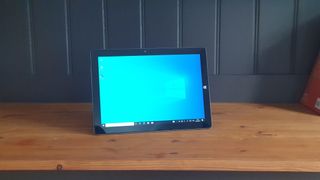
On the front of the iWork 20 Pro is a 10.5-inch full HD+ (1920 x 1280 pixels, 3:2 aspect ratio), fully laminated IPS display with a front-facing 2-megapixel webcam. The panel seems to be covered with an oleophobic layer. At the rear is located a 5-megapixel snapper, useful for quick outdoor shots on a work site.

Connectors include a Type-C USB port, two full size USB 3.0 ones, a micro HDMI output, a 3.5mm audio jack, a microSD card slot and a 3.5mm barrel type connector.
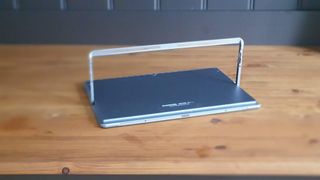
The lower edge of the device hosts a POGO connector for the keyboard cover while the power button and a volume rocker can be found on the top edge.

When it comes to dimensions, the iWork 20 Pro measures 255 x 181 x 9.6mm for a weight of 600g, add another 5mm and 249g for the keyboard. Note that the 1024-level pressure-sensitive stylus is - sadly - optional and will cost you extra. An adjustable kickstand ensures that the device is at the right angle, every time and hides two speaker grills.
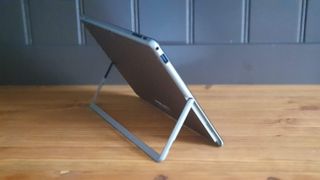
Hardware
Here are the full specs of the Alldocube iWork 20 Pro:
CPU: Intel Celeron N4120
Graphics: Intel UHD Graphics 600
RAM: 8GB LPDDR4
Screen: 10.5-inch 1920 x 1280 full HD+ resolution
Storage: 128GB SSD (Faspeed K7N-128GH)
Ports: 1 x USB-C, 2 x USB 3.0, 1 x micro-HDMI, microSD card reader, audio jack
Connectivity: Realtek 8821CE, Wi-Fi , Bluetooth 4.2
Weight: 600g
Size: 255 x 181 x 9.6mm (H x W x D)
Battery: 26.6WHr
The hardware platform used by the iWork 20 Pro is a popular one which found its way in many entry level laptops, mini PCs and 2-in-1 tablets. There’s the ubiquitous Intel Celeron N4120 processor with four cores, four threads and an Intel UHD Graphics 600. Launched in 2020, popular benchmark CPUBenchmark indicates that it is just slightly slower than the Core i5-5200U, a processor launched in 2015.
It is paired with 8GB of LPDDR4 memory and a 128GB SSD from an obscure Vietnamese manufacturer (Faspeed K7N-128GH), most likely one that can be upgraded. Other features include a 26.6WHr battery - powered by a 12V, 2A (24W) power supply unit, a Realtek 8821CE Wireless LAN card that offers 802.11ac Wi-Fi and Bluetooth 4.2.
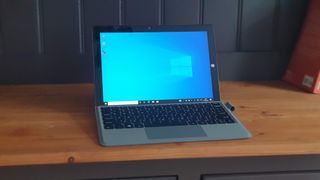
Performance and in use
The laptop is powered by Windows 10 and it is unclear whether it will be able to run Windows 11. There’s no bloatware, which is a definite win in our books. The N4120 is a tad slower than the m3-8100Y (found inside the Surface Go 2) when it comes to sheer compute power and while the device uses an SSD, it is actually one of the slowest we’ve come across yet.
Here’s how the Alldocube iWork 20 Pro performed in our suite of benchmark tests:
Passmark: 909
Passmark CPU: 3126
CPU-Z: 200 (single-thread); 809 (multi-thread)
CrystalDiskMark: 503MBps (read); 326MBps (write)
Cinebench: 425
Novabench: 730
Atto: 480MBps (read, 256mb); 324MBps (write, 256mb)
AJA: 452MBps (read); 308MBps (write)
Windows Experience Index: 4.4
As for general user experience, the iWork 20 Pro exhibits the usual limitations associated with tiny Windows devices with that form factor. The keyboard remains the biggest victim as it is just good enough for short typing bursts because of the smaller, flatter keys that lack feedback. The touchpad is more rectangular than what we’d expect; at 48 x 100mm, it is significantly smaller than the competition.
The screen however is the icing on the cake. It is bright, crisp, with a higher than usual pixel density, dark blacks and good contrast. Oh and the 3:2 aspect ratio works really well and feels natural when tackling typing tasks.
The battery life is also another surprise at just over five hours on our count up YouTube test with brightness set to maximum and power saving features disabled. Given the small battery capacity, the fact that the iWork 20 ran for so long away from its charger is a definite positive.
Should I buy the Alldocube iWork 20 Pro 2-in-1 Windows tablet?
Buy it if:
You want the smallest, affordable rival to the Surface Go 3 with a bundled keyboard
The Alldocube iWork fills a well targeted niche. There are cheaper Windows tablets but they don’t offer a bundled keyboard AND match the 10.5-inch form factor AND deliver 8GB of RAM. Overall, if portability is at the top of your list, then so should the iWork 20 Pro.
Don’t buy if if:
You want the cheapest alternative to the Surface Go 3
Assuming you don’t mind a slightly bigger form factor, the Pipo W11 (much cheaper at $280 plus it comes with a stylus pen and double the storage) or the Chuwi Ubook ($330 with a faster 256GB SSD) are probably better alternatives.

You plan to use it a lot for touch typing
The form factor and the keyboard do not lend themselves well to prolonged typing. Get yourself a convertible laptop instead (like the BMax Y11) if you want to experience decent portability without compromising too much on the keyboard.
We've also highlighted the best business tablets, and best tablets with keyboard.
Want something different? Then check out the Onyx Boox Note Air, an Android tablet that wants to replace your notepad.

Désiré has been musing and writing about technology during a career spanning four decades. He dabbled in website builders and web hosting when DHTML and frames were in vogue and started narrating about the impact of technology on society just before the start of the Y2K hysteria at the turn of the last millennium.
